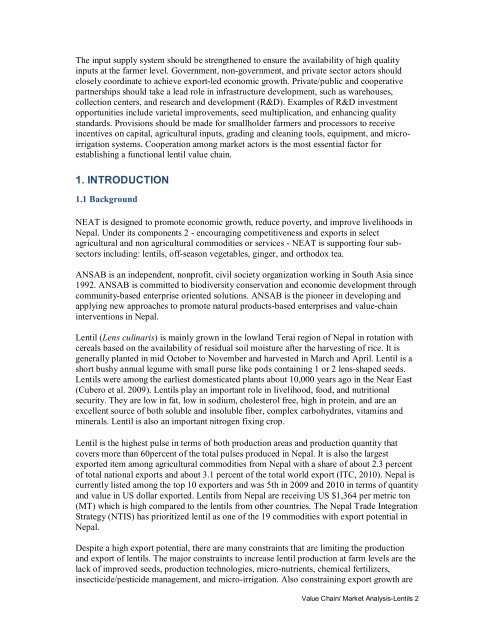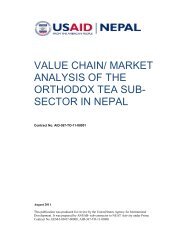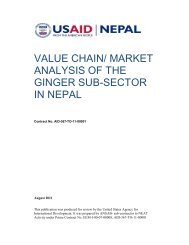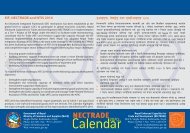value chain/ market analysis of the lentil sub-sector in ... - Nepal Trade
value chain/ market analysis of the lentil sub-sector in ... - Nepal Trade
value chain/ market analysis of the lentil sub-sector in ... - Nepal Trade
Create successful ePaper yourself
Turn your PDF publications into a flip-book with our unique Google optimized e-Paper software.
The <strong>in</strong>put supply system should be streng<strong>the</strong>ned to ensure <strong>the</strong> availability <strong>of</strong> high quality<br />
<strong>in</strong>puts at <strong>the</strong> farmer level. Government, non-government, and private <strong>sector</strong> actors should<br />
closely coord<strong>in</strong>ate to achieve export-led economic growth. Private/public and cooperative<br />
partnerships should take a lead role <strong>in</strong> <strong>in</strong>frastructure development, such as warehouses,<br />
collection centers, and research and development (R&D). Examples <strong>of</strong> R&D <strong>in</strong>vestment<br />
opportunities <strong>in</strong>clude varietal improvements, seed multiplication, and enhanc<strong>in</strong>g quality<br />
standards. Provisions should be made for smallholder farmers and processors to receive<br />
<strong>in</strong>centives on capital, agricultural <strong>in</strong>puts, grad<strong>in</strong>g and clean<strong>in</strong>g tools, equipment, and microirrigation<br />
systems. Cooperation among <strong>market</strong> actors is <strong>the</strong> most essential factor for<br />
establish<strong>in</strong>g a functional <strong>lentil</strong> <strong>value</strong> <strong>cha<strong>in</strong></strong>.<br />
1. INTRODUCTION<br />
1.1 Background<br />
NEAT is designed to promote economic growth, reduce poverty, and improve livelihoods <strong>in</strong><br />
<strong>Nepal</strong>. Under its components 2 - encourag<strong>in</strong>g competitiveness and exports <strong>in</strong> select<br />
agricultural and non agricultural commodities or services - NEAT is support<strong>in</strong>g four <strong>sub</strong><strong>sector</strong>s<br />
<strong>in</strong>clud<strong>in</strong>g: <strong>lentil</strong>s, <strong>of</strong>f-season vegetables, g<strong>in</strong>ger, and orthodox tea.<br />
ANSAB is an <strong>in</strong>dependent, nonpr<strong>of</strong>it, civil society organization work<strong>in</strong>g <strong>in</strong> South Asia s<strong>in</strong>ce<br />
1992. ANSAB is committed to biodiversity conservation and economic development through<br />
community-based enterprise oriented solutions. ANSAB is <strong>the</strong> pioneer <strong>in</strong> develop<strong>in</strong>g and<br />
apply<strong>in</strong>g new approaches to promote natural products-based enterprises and <strong>value</strong>-<strong>cha<strong>in</strong></strong><br />
<strong>in</strong>terventions <strong>in</strong> <strong>Nepal</strong>.<br />
Lentil (Lens cul<strong>in</strong>aris) is ma<strong>in</strong>ly grown <strong>in</strong> <strong>the</strong> lowland Terai region <strong>of</strong> <strong>Nepal</strong> <strong>in</strong> rotation with<br />
cereals based on <strong>the</strong> availability <strong>of</strong> residual soil moisture after <strong>the</strong> harvest<strong>in</strong>g <strong>of</strong> rice. It is<br />
generally planted <strong>in</strong> mid October to November and harvested <strong>in</strong> March and April. Lentil is a<br />
short bushy annual legume with small purse like pods conta<strong>in</strong><strong>in</strong>g 1 or 2 lens-shaped seeds.<br />
Lentils were among <strong>the</strong> earliest domesticated plants about 10,000 years ago <strong>in</strong> <strong>the</strong> Near East<br />
(Cubero et al. 2009). Lentils play an important role <strong>in</strong> livelihood, food, and nutritional<br />
security. They are low <strong>in</strong> fat, low <strong>in</strong> sodium, cholesterol free, high <strong>in</strong> prote<strong>in</strong>, and are an<br />
excellent source <strong>of</strong> both soluble and <strong>in</strong>soluble fiber, complex carbohydrates, vitam<strong>in</strong>s and<br />
m<strong>in</strong>erals. Lentil is also an important nitrogen fix<strong>in</strong>g crop.<br />
Lentil is <strong>the</strong> highest pulse <strong>in</strong> terms <strong>of</strong> both production areas and production quantity that<br />
covers more than 60percent <strong>of</strong> <strong>the</strong> total pulses produced <strong>in</strong> <strong>Nepal</strong>. It is also <strong>the</strong> largest<br />
exported item among agricultural commodities from <strong>Nepal</strong> with a share <strong>of</strong> about 2.3 percent<br />
<strong>of</strong> total national exports and about 3.1 percent <strong>of</strong> <strong>the</strong> total world export (ITC, 2010). <strong>Nepal</strong> is<br />
currently listed among <strong>the</strong> top 10 exporters and was 5th <strong>in</strong> 2009 and 2010 <strong>in</strong> terms <strong>of</strong> quantity<br />
and <strong>value</strong> <strong>in</strong> US dollar exported. Lentils from <strong>Nepal</strong> are receiv<strong>in</strong>g US $1,364 per metric ton<br />
(MT) which is high compared to <strong>the</strong> <strong>lentil</strong>s from o<strong>the</strong>r countries. The <strong>Nepal</strong> <strong>Trade</strong> Integration<br />
Strategy (NTIS) has prioritized <strong>lentil</strong> as one <strong>of</strong> <strong>the</strong> 19 commodities with export potential <strong>in</strong><br />
<strong>Nepal</strong>.<br />
Despite a high export potential, <strong>the</strong>re are many constra<strong>in</strong>ts that are limit<strong>in</strong>g <strong>the</strong> production<br />
and export <strong>of</strong> <strong>lentil</strong>s. The major constra<strong>in</strong>ts to <strong>in</strong>crease <strong>lentil</strong> production at farm levels are <strong>the</strong><br />
lack <strong>of</strong> improved seeds, production technologies, micro-nutrients, chemical fertilizers,<br />
<strong>in</strong>secticide/pesticide management, and micro-irrigation. Also constra<strong>in</strong><strong>in</strong>g export growth are<br />
Value Cha<strong>in</strong>/ Market Analysis-Lentils 2






